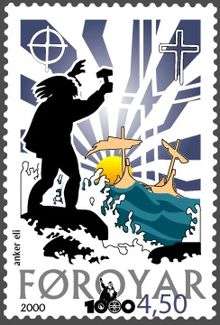Tróndur í Gøtu
| Tróndur í Gøtu | |
|---|---|
| Born |
945 Faroe Islands |
| Died | 1035 |
| Parent(s) | Torbjørn Gøtuskegg and Guðrún |
Tróndur í Gøtu (Old Icelandic: Þrándr í Götu, Old Norse Þrǫ́ndr í Gǫtu) (ca. 945 – 1035) was a viking from the Faroe Islands. He and Sigmundur Brestisson are the central figures in the Færeyinga saga, which tells the early history of the Faroe Islands and the coming of Christianity to the islands, which Tróndur opposed.
Chapter three of the Saga describes Tróndur as having "a shock head of red hair, and . . . freckled of face and right grim of look", features which were inherent to Faroese, who are said to have descended from Thorstan the Red's daughter.
Tróndur í Gøtu lived on the island of Eysturoy, in his father's home Gøta, which was named for Torbjørn Gøtuskegg's nickname "Gatebeard". Initially Tróndur and his brother Thorlac drew lots to decide who should inherit the estate. After losing, Thorlac went to live in neighbouring islands with his wife. Chapter 35 of the saga tells that all siblings eventually lived together at Gøta, with their respective children. This same chapter explains that Thorlac had two sons, Sigurd (a strong man with blond curly hair) and Thord (also called "The Low" for his stout yet strong figure); Tróndur's sister had a son known as "Geat the Red".
Tróndur opposed Christianization of the Faroes and pronounced a curse against the religion and Sigmundur, who was promulgating it. This is the subject of a Faroese poem by Janus Djurhuus, "Gandkvæði Tróndar".
 Tróndur í Gøtu raises the hammer of Thor against the arrival of Christianity in the Faroes, on a 2000 stamp
Tróndur í Gøtu raises the hammer of Thor against the arrival of Christianity in the Faroes, on a 2000 stamp Tróndur í Gøtu chants his curse against Christianity and Sigmundur Brestisson; 2004 stamp illustrating Janus Djurhuus' poem
Tróndur í Gøtu chants his curse against Christianity and Sigmundur Brestisson; 2004 stamp illustrating Janus Djurhuus' poem
As the Icelandic saying
The saying in Icelandic, "vera einhverjum Þrándur í Götu",[1] (e. being someones Þrándur í Götu) or just "að vera þrándur í götu"[2] (e. to be a þrándur í götu), means (probably unknown, to most Icelanders, let alone that Þrándur was viking, explaining why the word/he þrándur and götu may be commonly lower cased as in the latter example) because Þrándur opposed taxation of Olav the King (while Icelanders might think that þrándur means a literal obstacle, that happens to be in the street (icel. í götu, note lower case).